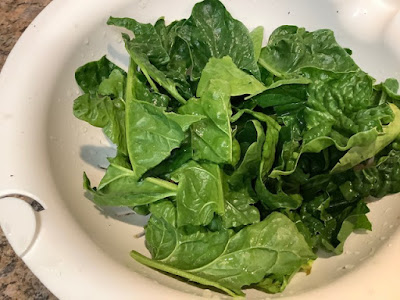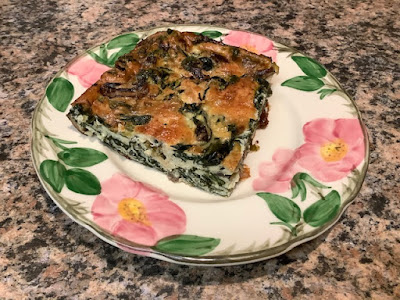
Recipe: Spinach-mushroom crustless quiche
 |
|
This spinach-mushroom quiche goes together easily.
(Photos: Debbie Arrington)
|
Spinach, eggs and cheese go together any time of day. This easy recipe combines fresh spinach, spring green onions, eggs, mushrooms and two cheeses into a crust-less quiche that’s great for breakfast, lunch, dinner or as a side dish. It’s a nice dish to share with friends, too; it can travel.
Sautéing the mushrooms, onions and spinach before adding to the egg mixture eliminates their extra moisture, making a firmer (not soggy) quiche – crust or no crust.
Spinach-mushroom crustless quiche
Makes 4 to 6 servings
Ingredients:
2 tablespoons butter (plus more to grease baking dish)
3 green onions, chopped
2 cups sliced mushrooms
3 large bunches spinach (about 6 cups, torn)
6 large eggs
1 cup cream
Dash of Tabasco sauce
1-3/4 cups Swiss cheese, grated
¼ cup Parmesan cheese, grated
 |
|
So fresh: The spinach was just picked and washed.
|
Instructions:
Preheat oven to 350 degrees F. Grease an 8-inch square baking dish; set aside.
In a large pan over medium heat, melt butter. Sauté chopped green onions (both white and green parts) and sliced mushrooms until the mushrooms start to loose their moisture, about 5 minutes.
Wash spinach and remove tough stems. Tear or cut into 1- or 2-inch pieces. Do not dry.
Add spinach, with whatever water is clinging to it, to onions and mushrooms in sauté pan, stirring to combine, and sauté until the leaves turn bright green. Cover pan, lower heat and cook briefly, about 3 to 4 minutes, until spinach is done, stirring occasionally. Watch the spinach so it doesn’t stick to the pan or burn. Remove from heat and let cool slightly.
In a large bowl, beat eggs. Add cream and dash of Tabasco; beat until blended. Fold in grated cheeses.
Fold in spinach-onion-mushroom mixture and stir until just blended.
 |
| Delicious served warm or at room temperature. |
Pour mixture into prepared baking dish. Bake at 350 degrees for 40 to 45 minutes or until top is golden and a thin-bladed knife, inserted near the center, comes out clean. Let cool slightly and serve warm or at room temperature.
Comments
0 comments have been posted.Sacramento Digs Gardening to your inbox.
Food in My Back Yard Series
May 6: Maintain soil moisture with mulch for garden success
April 29: What's (already) wrong with my tomato plants?
April 22: Should you stock up on fertilizer? (Yes!)
April 15: Grow culinary herbs in containers
April 8: When to plant summer vegetables
April 1: Don't be fooled by these garden myths
March 25: Fertilizer tips: How to 'feed' your vegetables for healthy growth
March 18: Time to give vegetable seedlings some more space
March 11: Ways to win the fight against weeds
March 4: Potatoes from the garden
Feb. 25: Plant a fruit tree now -- for later
Feb. 18: How to squeeze more food into less space
Feb. 11: When to plant? Consider staggering your transplants
Feb. 4: Starting in seed starting
Sites We Like
Garden Checklist for week of May 4
Enjoy this spring weather – and get gardening!
* Plant, plant, plant! It’s prime planting season in the Sacramento area. Time to set out those tomato transplants along with peppers and eggplants. Pinch off any flowers on new transplants to make them concentrate on establishing roots instead of setting premature fruit.
* Direct-seed melons, cucumbers, summer squash, corn, radishes, pumpkins and annual herbs such as basil.
* Harvest cabbage, lettuce, peas and green onions.
* In the flower garden, direct-seed sunflowers, cosmos, salvia, zinnias, marigolds, celosia and asters. (You also can transplant seedlings for many of the same flowers.)
* Plant dahlia tubers. Other perennials to set out include verbena, coreopsis, coneflower and astilbe.
* Transplant petunias, marigolds and perennial flowers such as astilbe, columbine, coneflowers, coreopsis, dahlias, rudbeckia and verbena.
* Keep an eye out for slugs, snails, earwigs and aphids that want to dine on tender new growth.
* Feed summer bloomers with a balanced fertilizer.
* For continued bloom, cut off spent flowers on roses as well as other flowering plants.
* Add mulch to the garden to maintain moisture. Mulch also cuts down on weeds. But don’t let it mound around the stems or trunks of trees or shrubs. Leave about a 6-inch to 1-foot circle to avoid crown rot or other problems.